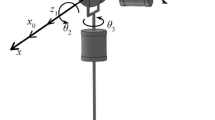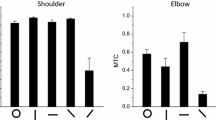Abstract
In previous research, criteria based on optimal theories were examined to explain trajectory features in time and space in multi joint arm movements. Four criteria have been proposed. They were the minimum hand jerk criterion, the minimum angle jerk criterion, the minimum torque change criterion, and the minimum commanded torque change criterion. Optimal trajectories based on the two former criteria can be calculated analytically. In contrast, optimal trajectories based on the minimum commanded torque change criterion are difficult to be calculated even with numerical methods. In some cases, they can be computed by a Newton-like method or a steepest descent method combined with a penalty method. However, for a realistic physical parameter range, a former becomes unstable quite often, and the latter is unreliable about the optimality of the obtained solution. In this paper, we propose a new method to stably calculate optimal trajectories based on the minimum commanded torque change criterion. The method can obtain trajectories satisfying Euler-Poisson equations with a sufficiently high accuracy. In the method, a joint angle trajectory, which satisfies the boundary conditions strictly, is expressed by using orthogonal polynomials. The coefficients of the orthogonal polynomials are estimated by using a linear iterative calculation so as to satisfy the Euler-Poisson equations with a sufficiently high accuracy. In numerical experiments, we show that the optimal solution can be computed in a wide work space and can also be obtained in a short time compared with the previous methods.
Preview
Unable to display preview. Download preview PDF.
Similar content being viewed by others
References
W. Abend, E. Bizzi, and P. Morasso. Human arm trajectory formation. Brain, 105:331–348, (1982).
E. Bizzi, N. Accornero, W. Chapple, and N. Hogan. Posture control and trajectory formation during arm movement. Journal of Neuroscience, 4:2738–2744, (1984).
T. Flash and N. Hogan. The coordination of arm movements: An experimentally confirmed mathematical model. Journal of Neuroscience, 5:1688–1703, (1985).
E. Nakano, H. Imamizu, R. Osu, Y. Uno, H. Gomi, T. Yoshioka, and M. Kawato. Quantitative examinations of internal representations for arm trajectory planning: minimum commanded torque change model. Journal of Neurophysiology, 81(5):2140–2155, (1999).
D. A. Rosenbaum, L. D. Loukopoulos, R. G. Meulenbriek, J. Vaughan, and S.E. Engelbrecht. Planning resaches by evaluating stored posture. Psychol. Rev., 102:28–67, (1995).
G. Szego. Orthogonal polynomials. American mathematical society, New York, 4th edition, (1975).
Y. Uno, M. Kawato, and R. Suzuki. Formation and control of optimal trajectory in human multijoint arm movement-minimum torque change model. Biological Cybernetics, 61:89–101, (1989).
Y. Wada, Y. Kaneko, E. Nakano, R. Osu, and M. Kawato. Quantitative examinations for multi joint arm trajectory planning by a strict and robust calculation algorithm of minimum commanded torque change trajectory. Neural Networks, 14(4):381–393, (2001).
Author information
Authors and Affiliations
Editor information
Editors and Affiliations
Rights and permissions
Copyright information
© 2001 Springer-Verlag Berlin Heidelberg
About this paper
Cite this paper
Wada, Y., Kaneko, Y., Nakano, E., Osu, R., Kawato, M. (2001). Multi-joint Arm Trajectory Formation Based on the Minimization Principle Using the Euler-Poisson Equation. In: Dorffner, G., Bischof, H., Hornik, K. (eds) Artificial Neural Networks — ICANN 2001. ICANN 2001. Lecture Notes in Computer Science, vol 2130. Springer, Berlin, Heidelberg. https://doi.org/10.1007/3-540-44668-0_135
Download citation
DOI: https://doi.org/10.1007/3-540-44668-0_135
Published:
Publisher Name: Springer, Berlin, Heidelberg
Print ISBN: 978-3-540-42486-4
Online ISBN: 978-3-540-44668-2
eBook Packages: Springer Book Archive




